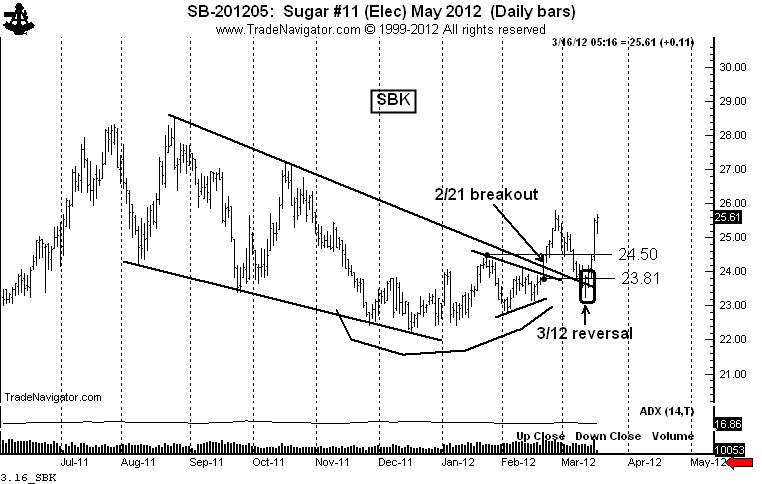A study in frustration: What do you do when you become a sold out bull?
It never fails. At least once each year I will be dead right on a market, but price action will frustrate my trading actions.
In 2012, the Sugar market is a leading candidate to meet the above definition. If you follow this blog you know that I have considered the charts in Sugar to indicate a massive advance — perhaps all the way to 65 cents. This judgement is based on the quarterly and monthly graphs.
Yet, an opinion is not a position. My trading plan dictates that I enter trade based on recognizable chart construction and that I use money management protocol to limit my loss to no more than 1% of capital (2% if all the stars are aligned in a market, which was not the case in Sugar).
On Feb. 21, May Sugar completed a 4-week symmetrical triangle (small patterns often complete larger chart construction) and penetrated the upper boundary of a 6-month falling wedge. Accordingly, I went long at an average price of around 24.22.
I fully expected that the market would do a moon shot. Yet, on Feb. 29 the market closed below the low of the high day of the move, which was Feb. 27. If you read my book, you might remember how this is a warning in what I call the “3-day trailing stop rule.”
I exited half of my position at 24.34 on Mar. 6 and the remainder of my position when the Last Day Rule of 23.81 (see book) was violated on Mar. 9. I had a sizable position in Sugar, and all of a sudden I was on the sidelines.
On Mar. 12 the market completed a one-day upward reversal. Normally a single day’s price action means nothing to me. However, when I think a market is poised for a big move a one-day reversal takes on significance. So, I reentered only half of my original position on the Mar. 13 open at 23.86.
Bottom line: The market is proving me to be correct and I have only half of the position I wanted to have.
So, what should be my response? Should I chase the market? Should I sulk and moan that the boat has left the harbor and I am still standing on the pier? Absolutely not. I will tell you what my opinion is of market situations such as this:
- A good trade must be right on both direction and timing. If one of these factors is wrong, the trade is wrong.
- I have trading rules and I must follow them. If my rules prevent me from participating in a market I correctly called, so be it.
- Traders MUST force discipline upon themselves, even if it means a move will be missed.
- There will always be another market. It is a sign of trouble when a trader feels he or she must be in a given market even if the set up was not right.
So I am long half of a position. I need to be happy about this. It is important for a technical trader to be driven by precise signal set ups, not by market opinions or emotions. Emotionally it is tough for me to watch Sugar rally. So what? Emotions are never a reason to be in a trade.
If the Sugar charts do not give me what I need to become fully positioned, well so be it, it will not be the first time nor will it be the last.
I have a stop at break-even. My guess is that somewhere along the way the Sugar charts will give me another chance to extend my position — and do so according to my terms. I never like trading a market according to its terms.
Markets: $SGG, $SB_F
.







Trackbacks & Pingbacks
[…] again, and he has some regret that he wasn’t as long as he wanted to be for the bounce. Click over and read his entire piece, but the point is this: discipline, discipline, discipline. There are other points too, and Peter […]
[…] Peter L. Brandt, “A good trade must be right on both direction and timing. If one of these factors is wrong, the trade is wrong.” (Peter L. Brandt) […]
Leave a Reply
Want to join the discussion?Feel free to contribute!